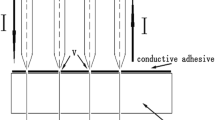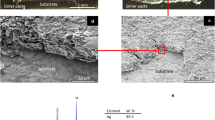Abstract
Electrically conductive adhesives (ECA) could soon constitute a realistic alternative to solders. The present research compares 10Sn90Pb solder paste in Japan to an epoxy based and isotropical ECA containing pure silver. The findings are that the silver containing adhesive likely is environmentally more advantageous than 10Sn90Pb. Environmental trade-offs exist especially between the ecotoxicity of Sn1090Pb and the resource consumption of silver-epoxy ECA. Palladium is significant platings included. Overall, the next steps would be to use improved global LCI metal production models and also to compare the life cycle cost to the social cost.
Access this chapter
Tax calculation will be finalised at checkout
Purchases are for personal use only
Preview
Unable to display preview. Download preview PDF.
Similar content being viewed by others
7 References
Li, Y. and Wong, C.P., 2006, Recent advances of conductive adhesives as a lead-free alternative in electronic packaging: Materials, processing, reliability and applications. Materials Science and Engineering, R 5:1–35.
Dansk Toksikologi Center, 2000, Life Cycle Assessment of Electrically Conductive Adhesive vs. Traditional Tin/Lead Solder, Horsholm, Denmark.
Andrae, A.S.G, Itsubo, N., Yamaguchi, H., Inaba, A., 2006, Screening Life Cycle Assessment of Silver-based Conductive Adhesive vs. Lead-based Solder and Plating Materials, Material Transactions Japan Institute of Metals, submitted.
Springer, U. and Varilek, M, 2004, Estimating the price of tradable permits for greenhouse gas emissions in 2008-12, Energy Policy, 32:611–621.
Harada, K. and Ijima, K., 2006, Hidden material flows by extraction of natural resources, Proceedings of workshop on material flows and environmental impacts associated with massive consumption of natural resources and products, Nov. 17, Tsukuba, Japan, 15–42.
Ekvall, T., 2000, A market-based approach to allocation at open-loop recycling, Resources, Conservation and Recycling, 29:91–109.
Carnegie Mellon Green Design Institute, 2006, URL-http://www.eiolca.net, Accessed 2007-02-28.
Terazono, A., 2006, Transboundary flows of end-of-life products and their environmental implications, Proceedings of workshop on Material Flows and Environmental Impacts associated with Massive Consumption of Natural Resources and Products, Nov. 17, Tsukuba, Japan, 43–58.
Ii, R. and Itsubo, N., 2006, Study on calculation model of environmental emissions of heavy metals from WEEE for LCCBA, Proceedings of 7th International Conference on Ecobalance, 14–16 Nov., Tsukuba, Japan, 285–288.
Shirahase, T. and Kida, A., 2006, Case study of metal contents in e-waste-analysis of 100 parts in a personal computer, Proceedings of the 3rd NIES Workshop on E-waste, 17–18 Nov., Tsukuba, Japan.
United States Environmental Protection Agency, 2005, EPA 744-R-05-001, Table 2-15, 2-38.
Uryu, T., Yoshinaga, J., Yanagisawa, Y., 2003, Environmental Fate of Gallium Arsenide Semiconductor Disposal, Industrial Ecology, 7:103–112.
Camargo, J. Alonso, A., 2006, Ecological and toxicological effects of inorganic nitrogen pollution in aquatic ecosystems: A global assessment, Environment International, 32:831–849.
Eshet, T., Ayalon, O., Shechter, M., 2006, Valuation of externalities of selected waste management alternatives: A comparative review and analysis, Resources, Conservation and Recycling, 46:335–364.
Tin Technology, 2007. URL: http://www.tintechnology.com/pooled/articles/BF_NEWSART/view.asp?Q=BF_NEWSART_232935 Accessed 2007-03-01.
Scottish Enterprise, 2006, Electronics Market Research-Global Electronics Report March 2006, Table 1, 8, URL: http://www.scottishenterprise.com/publications/se_mkt_reports_global_electronics_march_2006.pdf, Accessed 2006-12-07.
Intergovernmental Panel on Climate Change, 2007, Climate Change 2007: The Physical Science Basis-Summary for Policy Makers-IPCC WGI Fourth Assessment Report, 3–18.
Author information
Authors and Affiliations
Editor information
Editors and Affiliations
Rights and permissions
Copyright information
© 2007 Springer-Verlag London Limited
About this paper
Cite this paper
Andrae, A.S.G., Itsubo, N., Yamaguchi, H., Inaba, A. (2007). Conductive Adhesives vs. Solder Paste: A Comparative Life Cycle Based Screening. In: Takata, S., Umeda, Y. (eds) Advances in Life Cycle Engineering for Sustainable Manufacturing Businesses. Springer, London. https://doi.org/10.1007/978-1-84628-935-4_50
Download citation
DOI: https://doi.org/10.1007/978-1-84628-935-4_50
Publisher Name: Springer, London
Print ISBN: 978-1-84628-934-7
Online ISBN: 978-1-84628-935-4
eBook Packages: EngineeringEngineering (R0)




